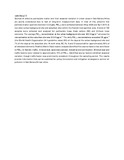| dc.contributor.author | Gaita, S. M | |
| dc.contributor.author | Boman, J | |
| dc.contributor.author | Gatari, MJ | |
| dc.contributor.author | Pettersson, J B C | |
| dc.contributor.author | Janhäll, S | |
| dc.date.accessioned | 2014-05-09T10:43:45Z | |
| dc.date.available | 2014-05-09T10:43:45Z | |
| dc.date.issued | 2014 | |
| dc.identifier.citation | M. Gaita, J. Boman M. J, Gatari J. B. C, and Janhäll, S. (2014). Source apportionment and seasonal variation of PM2.5 in a Sub-Sahara African city: Nairobi, Kenya. Atmospheric Chemistry and Physics Discussions, 14( 7), pp.9565-9601 | en_US |
| dc.identifier.uri | http://adsabs.harvard.edu/abs/2014ACPD...14.9565G | |
| dc.identifier.uri | http://hdl.handle.net/11295/66408 | |
| dc.description.abstract | Sources of airborne particulate matter and their seasonal variation in urban areas in Sub-Sahara Africa are poorly understood due to lack of long-term measurement data. In view of this, airborne fine particles matter (particle diameter ≤ 2.5 μm, PM2.5) were collected between May 2008 and April 2010 at two sites (urban background site and suburban site) within the Nairobi metropolitan area. A total of 780 samples were collected and analyzed for particulate mass, black carbon (BC) and thirteen trace elements. The average PM2.5 concentration at the urban background site was 20 ± 8 μg m-3 whereas the concentration at the suburban site was 13 ± 8 μg m-3. The daily PM2.5 concentrations exceeded 25 μg m-3 (the World Health Organization 24 h guideline value) 29% of the days at the urban background site and 7% of the days at the suburban site. At both sites, BC, Fe, S and Cl accounted for approximately 80% of all detected elements. Positive Matrix Factorization analysis identified five source factors that contribute to PM2.5 in Nairobi; traffic, mineral dust, secondary aerosol, industrial and combustion. Mineral dust and traffic factors were related to approximately 74% of PM2.5. Identified source factors exhibited seasonal variation though traffic factor was prominently consistent throughout the sampling period. The results provide information that can be exploited for policy formulation and mitigation strategies to control air pollution in Sub-Sahara African cities. | en_US |
| dc.language.iso | en | en_US |
| dc.publisher | University of Nairobi | en_US |
| dc.title | Source apportionment and seasonal variation of PM2.5 in a Sub-Sahara African city: Nairobi, Kenya | en_US |
| dc.type | Presentation | en_US |


